

DIY Cruising Catamaran: Complete Building Guide
As an Amazon Associate, we earn from qualifying purchases. We may also earn commissions if you purchase products from other retailers after clicking on a link from our site.
A brand-new cruising catamaran can set you back a hefty amount of money. However, a DIY cruising catamaran provides a more affordable way to own your own boat. While building a large boat can be an extremely challenging and time-consuming experience, nothing beats the pleasure of bringing your own boat to life.
To build a DIY cruising catamaran, buy good design plans, determine your budget and find a working space. Next, choose your hull material, buy supplies and start building the mast beam. Build and sheathe the hull, install bulkheads, the interior, and finally, launch the catamaran boat.
In this article, you will find a complete guide to building your own catamaran. You will also find detailed information on why you may want to consider building your catamaran and approximately how much this project would cost. Finally, we will explore the advantages and disadvantages of building a catamaran from scratch.
Why You Might Want To Build Your Own Catamaran
Most people might think that purchasing a used boat to repair and fix it up would be cheaper than a DIY cruising catamaran. But while building your own catamaran could be an enormous undertaking, it also comes with many advantages over buying something used.
Other than the unique opportunity to create beautiful memories and experiences while cruising, sailing, and exploring beautiful coastlines, there are a number of benefits that come along with the DIY approach.
Knowing Your Boat
Building your own catamaran provides you with intimate knowledge of your boat. You will know every corner, including where to find every bolt, wire, bulkhead, rib, hose, and support as you installed them yourself. This knowledge will enhance your confidence while at sea since you will have entrusted your life to a boat whose history you are aware of and deeply connected to.
Pride of Ownership
The satisfaction you get from crafting something with your own hands is immense. As a result, the knowledge that you built your boat from scratch will fill you with absolute pride and an immense sense of achievement. Furthermore, as an owner-builder, you get to keep and enjoy the boat for as many years as you wish.
Substantial Cost Savings
Building your catamaran will work out cheaper than buying a new or even gently used boat. Though you will likely require some additional labor since doing some things will require an extra pair of hands, if you are particularly good at DIY, you will save a significant amount of money on labor costs as a whole.
Freedom To Create Your Own Designs
If you decide to buy a catamaran boat, it might not be easy to find one that meets your unique needs. However, instead of choosing from production boats that bear traditional and outdated designs, you can come up with an ultra-modern design or style for your catamaran. You also get to pick your layout, size, and equipment based on your taste and budget.
Great Learning Experience
Building your own boat will help you pick up numerous skills that will come in handy later when sailing your boat. As much as you might still require an expert to help you with specialized skills like carpentry or wiring, your new skills will serve you well. This will also be beneficial when it comes to your boat’s maintenance and fixing things for yourself.
What To Look For in Catamaran Boat Designs
When deciding on the type of catamaran boat to build, you may want to choose a design that’s simple and easy to build. This is because doing so will allow you to spend a shorter time building the boat.
You also need to have a set of requirements to guide you in choosing your design or what you might call an ideal cruising catamaran wish list. This is essential because, ultimately, you want to build a boat that offers outstanding qualities such as:
- Delivers good speed
- Affordable to own and operate
- Agile, strong, and easy to maintain
- Has a high resistance to capsizing
- Great for sailing and cruising
- Delivers a comfortable and easy motion underway
- Good handling ability and high performance under sail
- User-friendly embarking and disembarking
- Provides ample living and accommodation space
- Presents a reasonable resale value
It’s worth noting that, in general, catamaran boats tend to offer a fair resale value mainly because of scarcity and the high price accorded to production models. So, if you build a well-constructed catamaran, you are bound to get a return that’s much higher than the cost of materials upon resale.
It’s also good to consider whether the design you settle on is from an established designer. This is significant because documentation of the building process is just as valuable when it comes to selling the boat.
How Much Would It Cost To Build Your Own Catamaran?
The cost of building your cruising catamaran will depend heavily on the size of the boat you plan to build and the skills you bring to the table. To give you an idea of probable costs, a professionally built 40 foot (12.1 m) long cruising catamaran could go for up to $300,000.
Though building it yourself will undoubtedly be cheaper, most DIY boatbuilders tend to underestimate the expected costs. Your final costs should cover not only the cost of material and equipment but also the labor and time it would take to come up with the final product.
If you were to build a 40-foot (12.1-meter) catamaran, your cost of materials would range between 20-30% of the total cost. Therefore, for $300,000 total, the boat’s materials would range between $60,000 and $90,000. The hull tends to range between 15-35% of the total build. Again, this depends on the finish and furniture.
But before you even start working on the DIY project, you will need to figure out where to do the work. If your home has ample space, then you can opt for a backyard building. But if you live in a small apartment, then you might want to consider renting a small garage at first and then move on to a boatyard later. This is one of the significant costs involved in building your multi-haul.
What You Will Need
To get a clearer picture of how much the entire project would cost, let’s have a look at what else you will need to purchase.
- Good design plans
- Working space
- Ground tackle
- Matting and roving
- Equipment such as the engine, windows, rudders, deck fittings, mast, and rigging
In addition to the above, you also need to install plumbing and electricals. You may also want to consider going electric rather than using diesel. Not only will this drastically reduce your maintenance costs, but you get to use the regenerated power for all of your housing needs while sailing.
Some catamaran boat designs help you save costs by advocating the use of less expensive corpus materials. Most of the material goes directly into making the boat, which means there is hardly any wastage on vacuum bagging . With this method, there are few molds and temporal building forms and fewer fillers to grind off as waste. All these factors reduce the time and cost it takes to build your catamaran boat.
That said, building a boat of any kind is a huge financial undertaking. As such, you still need to have the financial ability to keep building; otherwise, your project will stall or take much longer than anticipated. Instead of enjoying yourself and making memories cruising to faraway lands, you might end up spending all your time building a seemingly never-ending boat.
To reiterate, this project is more of a labor of love, given that it involves a tremendous amount of manual work. Calculating an hourly rate on the time spent building the boat and adding this cost to that of materials may make it seem a very pricey exercise. However, it is vital to understand that your time matters, and every hour you spend working for “free” should be included.
With that in mind, you need to ensure that you are fully devoted to the boat construction project and are sure you want to do it before you begin. Stopping halfway because it seems like too much work would be incredibly costly.
How To Build a Catamaran
When it comes to building a cruising catamaran, you have 3 main options:
- You can buy an old boat and refurbish it.
- Purchase a bare hull plus deck molding for a home-boat building.
- Start from scratch and build everything, including the hull, on your own.
As mentioned above, renovating an existing boat may end up being more costly than starting from scratch. To build a catamaran boat from scratch, follow the below step-by-step guide.
Prepare the Essentials
Before you jump into such a large project, there are several important aspects to consider:
- Buy your plans from an established catamaran designer. You can also get inexpensive, easy-to-build catamaran designs online.
- Get access to a large working space or build a shed . Depending on your climate, you may need to opt for climate control to avoid an excess of moisture in humid areas.
- Decide on your choice of hull material. This could be fiberglass, aluminum, steel, wood, or ferroconcrete.
- Start working on a bill of materials estimate. Include everything that you think you need to get a better idea of the initial costs.
Build the Mast Beam
Using wood and epoxy, cut and glue together the pieces of wood that will form the mast beam. Most of the work at this stage can occur in a garage since it involves building small parts. Still, the work could take up to 4 months, so be prepared to put in long hours.
Build the Boat Hull
Now, it’s time to build the boat’s hull. A catamaran comprises two hulls which are connected with a deck. Below is a short video showing how to build a hull mold:
This work requires a larger facility, so you might need to move out of the garage and into a boatyard. If you don’t have access to a larger workshop, consider building a shed where you can work as you do the construction. Make sure there’s enough room to fit the boat and also allow you to work comfortably. To cover the shed, you can use opaque white tarps.
Sheathe the Hull
Get all the materials you require for this stage in the construction, such as lots of resin, fiberglass, and foam for use in the hull cores. You’ll also require matting and glass roving to sheath the hull .
Sheathing helps to make the hull impervious to water and other marine borers. But first, you need to prepare the hull using a rotary sander. To make it as smooth as possible, use light, sweeping strokes. This is a very dusty task so be prepared to wear a facemask and safety goggles.
Install the Bulkheads
Next is installing the plywood bulkheads . You might need to call in friends to help turn the hulls or use a crane. In this step, you will need to laminate the hull sides on the molded hull panels and bond them above the bulkheads. Ensure the bulkheads are snug and sealed in place.
Construct the Interior Structure
Over the next couple of months, the boat work will involve joining the hulls together with the beams that you had made back in the garage. Then, install the cuddy cabin, decks , and the cockpit . Soon the boat will start to take the shape of a catamaran.
Next, proceed to construct the major structural components such as stairs, hatches, mini-keels, and the interior. Then comes the work of fairing the boat, which is quite labor-intensive.
Finally, it’s time to apply primer on the catamaran boat and start the paintwork. Before painting the boat, you will need to do additional sanding to finish off the two layers of primer as well as fill all the pinholes. Since it’s a large boat, the catamaran has lots of surface area; thus, the sanding could get extremely exhausting—mentally and physically—at this point.
The painting can take a while, too. The hulls are the easiest to paint, but the topsides, non-skid, as well as masking and prepping could seem never-ending.
The final stretch involves working on the center bridge deck cabin and other final touches like installing the engines, electricals, and plumbing. This is also the time to fix the rudders, rigging, mast, windows, and deck fittings.
Launch Your Cruising Catamaran
After many months or years of hard work, your cruising catamaran is finally ready to test the waters. After lowering the boat into the water, check carefully in case there are leaks. If none, you can set up the sails and take your catamaran out for your first cruise.
Below is a short video that takes you through the entire boat-building process:
If you don’t have deep pockets, don’t despair. It’s also possible to build an inexpensive catamaran boat, as shown in this post from the coastal passage .
The Pros of Building a Catamaran
Though it will be a costly endeavor, there are so many things to look forward to should you decide to build your own catamaran:
- It can be lots of fun.
- You get to have a new boat.
- It’s an excellent hobby for DIY enthusiasts.
- The effort is rewarding.
- It offers a great learning experience.
- You get the exact kind of boat you want.
- You can alter building plans and tailor the boat to suit your specific needs.
- It might be cheaper than buying a new boat.
The Cons of Building a Catamaran
Though there are a number of positive aspects to a DIY build, it is just as important to keep in mind that it won’t always be easy:
- Maintenance costs can be quite high.
- It’s both mentally and physically exhausting.
- It might require some technical know-how.
- It can take many months or even years to complete.
- It requires a lot of commitment to finish the DIY project.
- It might be challenging as well as expensive to get insurance.
- You will spend almost all your free time building the boat.
DIY Cruising Catamaran Tips and Tricks
If you are new to boat building, it would be a good idea to build a small boat first. This would give you a good indication as to whether you’d enjoy tackling a more extensive project like building a catamaran. Again, if you are the handy type, fixing your own electronics could also save you a significant amount of money.
Here are more tips and tricks to get the most out of your DIY cruising catamaran:
- Lower your costs. Bring down your costs even further by sourcing for parts and supplies at marine surplus outlets, Craigslist, eBay, or wholesale suppliers.
- Enhance your resale value. Most home-built boats are not easy to sell since they tend to be too customized. To enhance your resale value, it’s advisable to work with a standard design from a well-established naval architect.
- Follow the design instructions. Make sure to follow the designer’s instructions regarding the type of materials and tools to use during the build to avoid making costly mistakes.
- Maintain your original budget. Avoid any additional customizations once you have started building the boat. Using good plans and sticking to them ensures that your budget doesn’t spiral out of control.
Final Thoughts
Building a catamaran is about more than saving money. It’s fun, exciting, fulfilling, and can be a great learning experience. While it might take many months of back-breaking work, comparative shopping and sourcing for materials will help you save a lot of money. Still, at the end of it all, you’ll have a beautiful catamaran boat, all ready for your first cruising adventure.
However, if you have neither the time nor the energy to build your own catamaran from scratch, refurbishing an existing hull might prove faster and easier. It also works out much cheaper than buying a new boat.
Owner of CatamaranFreedom.com. A minimalist that has lived in a caravan in Sweden, 35ft Monohull in the Bahamas, and right now in his self-built Van. He just started the next adventure, to circumnavigate the world on a Catamaran!
One thought on “ DIY Cruising Catamaran: Complete Building Guide ”
Hello, I am a French Quebecer who is original, imaginative, creative and who finds that all boats and catamarans have a huge flaw and a very big lack of logic. I would have a brand new concept…. I am sending this message to any catamaran creator – designer to make those who have the opportunity and the intelligence to want to know about my innovative idea which will finally upset the market much richer. An idea that will totally change the concept of sailing, navigation and save so much worry!! All I would ask for is a small percentage of each sale of the new product. To be able to make me produce one when I have enough!! It is certain that like that, you just want to tell me: come on Mr. Lessard give us your idea but do not take your word to help me in return! But, if you are the kind of man to have only one word and maybe have a proof of your good faith if the realization of the project would make it… I will be very happy!! Giving it to everyone wouldn’t bother me either…. all I would like is to be able to find flax fiber (too expensive carbon) to be able to try to make my catamaran myself. Because not rich! Have a nice day and looking forward to having a message!!
Leave a Reply Cancel reply
Your email address will not be published. Required fields are marked *
Save my name and email in this browser for the next time I comment.
Recent Posts
Must-Have Boat Gear for Catamaran Sailors!
Sailing is probably the most gear-intensive activity I've ever done; there are so many decisions to be made about what gear to buy now, for tomorrow, and what to definitely never buy. The gear on...
6 Best Trailerable Trimarans For Bluewater and Coastal Sailing
Having a boat costs a lot of money, even when you are not using it, marina fees, etc. And once it is in the water most sailors never go very far from their "home marina" and sailing will be somewhat...

MIKE WALLER
Yacht design.

WE SPECIALIZE IN BOAT PLANS FOR AMATEUR BUILDERS
We provide stock boat plans for both monohull and multihull sailing vessels, including sailing skiffs and sharpies. Our designs mainly feature timber construction, in plywood or cedar strip plank composite construction, using the W.E.S.T. system (wood epoxy saturation technique). Our designs are intended mainly as cruising boats, although several have done well in racing. All designs are suitable for amateur boat builders.

MONOHULLS
multihulls , photos from our builders.
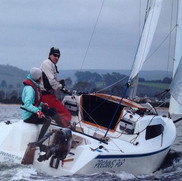
Photo galleries are provided on each design page where available

Catamaran Plans: Design, Build and Sail your own Multi-Hull Boat
Table of Contents
Why Build a Catamaran: The Benefits of Multi-Hull Boats
Building a catamaran offers many benefits over traditional monohull boats. One of the main advantages of catamarans is their stability. With two hulls instead of one, catamarans have a lower center of gravity, which makes them less likely to tip over in rough waters. This makes them ideal for families with children, or for anyone who wants to feel more secure while on the water.
Another benefit of catamarans is their increased speed and efficiency. The two hulls of a catamaran can displace more water than a single hull, which means they can move through the water faster and with less resistance. This makes them ideal for racing or for anyone who wants to cover more ground in less time. Additionally, Catamarans are also known for their space, as the twin-hull design provides more room for living and storage than a monohull.

Catamarans also offer more flexibility in terms of design. The two hulls of a catamaran can be configured in many different ways, which allows for a wide range of customization options. For example, one hull can be used for sleeping quarters, while the other can be used for storage or as a cockpit. This makes catamarans ideal for long-term cruising or for anyone who wants to create a unique and personalized boat.
Finally, catamarans are also more environmentally friendly than monohulls. Because they are more efficient, they can move through the water with less fuel consumption, which reduces their carbon footprint. Additionally, many catamaran designs incorporate solar panels and other renewable energy sources, which makes them ideal for anyone who wants to minimize their environmental impact while enjoying the water.
Designing Your Own Catamaran: Tips and Tricks
Designing your own catamaran can be a challenging but rewarding experience. Before you begin, it’s important to consider your needs and goals for the boat. Are you planning to use it for racing, cruising, or a combination of both? How many people will be on board? What kind of conditions will you be sailing in? Answering these questions will help you to determine the size, shape, and features of your catamaran.
One important tip when designing your catamaran is to keep it simple. While it can be tempting to add a lot of bells and whistles, the more complex your design, the more difficult and expensive it will be to build and maintain. Instead, focus on creating a functional and efficient boat that meets your needs.

Another tip is to take into account the materials you will be using. Different materials have different properties and costs, so it’s important to choose the right ones for your design. For example, wood is a traditional and affordable material, but it requires more maintenance than fiberglass. On the other hand, composites materials are more expensive but offer great weight to strength ratio.
Finally, it’s important to consult with experts and professionals during the design process. There are many resources available, such as online forums, books, and classes, that can help you to learn more about catamaran design and construction. Additionally, you should consider consulting with naval architects, boat builders, and other experts who can offer guidance and feedback on your design. They can help you to refine your ideas and ensure that your boat is safe and seaworthy.
Materials and Tools Needed for Building a Catamaran
Building a catamaran requires a variety of materials and tools. The materials you will need will depend on the design of your catamaran and the type of construction you choose. Common materials used in catamaran construction include wood, fiberglass, composites, aluminum, and PVC. Each material has its own unique properties and benefits, so it’s important to choose the right one for your project.
When it comes to tools, you will need a basic set of hand and power tools to complete your catamaran project. These include saws, drills, sanders, and other tools that are commonly used in woodworking or metalworking. Additionally, you will need specialized tools such as a router, a band saw, and a vacuum bagging system if you are building with composites materials.

In addition to the above tools, you will also need safety gear, such as goggles, respirators, and ear protection. Building a catamaran can be a challenging and time-consuming process, so it’s important to take the necessary precautions to protect yourself and others. Additionally, it’s important to have a well-ventilated workspace, as some of the materials and chemicals used in catamaran construction can be harmful if inhaled.
Common Mistakes to Avoid When Building a Catamaran
Building a catamaran can be a complex and challenging process, and it’s easy to make mistakes if you’re not careful. Here are some common mistakes to avoid when building a catamaran:
One of the most common mistakes is not properly planning and designing your catamaran. This can lead to problems later on in the construction process, such as not having enough room for your intended use or not being able to fit certain components. It is important to take the time to carefully plan and design your catamaran, taking into account your needs, goals and the materials you will be using.
Another common mistake is not properly preparing your materials. This can include not properly storing or protecting the materials from the elements, or not properly cutting or shaping the materials before assembly. Proper preparation of materials is essential to ensure that your catamaran is strong and durable.
A third mistake is not using the right tools or not using them properly. This can lead to problems such as not being able to cut or shape the materials correctly, or not being able to assemble the boat properly. It’s important to research and invest in the right tools for the job, and to learn how to use them properly before starting the construction process.

Another common mistake is not properly securing and aligning the components during assembly. This can lead to problems such as leaks, or the boat being unstable on the water. It’s important to take your time and to work carefully to ensure that everything is properly aligned and secured.
Finally, not following safety guidelines is a mistake that should be avoided. This can include not wearing protective gear, not having proper ventilation, or not taking the necessary precautions to protect yourself and others. Building a catamaran can be a challenging process, but it’s important to prioritize safety to prevent accidents or injuries.
After completing the construction of your catamaran, there are several important steps to take before launching it. These include finishing the exterior and interior of the boat, and performing necessary safety checks.
Finishing and Launching Your Catamaran
Finishing the exterior of your catamaran involves tasks such as painting, varnishing, or applying gel coat. This step is important to protect the boat from the elements and give it a professional look. It’s important to use the right type of paint or finish for the materials you used in the construction, and to follow the manufacturer’s instructions.
Similarly, finishing the interior of your catamaran involves tasks such as installing cabinetry, flooring, and other finishing touches. This step is important to make the boat more comfortable and functional. You can add amenities such as a kitchen, a bathroom, and a sleeping area.
After the finishing is done, it’s important to perform safety checks on your catamaran before launching. This includes checking the boat’s systems such as electrical, plumbing, and navigation. You should also check that all the safety equipment is in place and working properly. This includes life jackets, flares, and fire extinguishers.

Once all the necessary steps are completed, you will be ready to launch your catamaran. Launching a catamaran is a complex process that requires coordination between the boat owner, the marina, and other professionals. The boat should be launched in a protected area with calm waters, and with the help of a crane or a trailer. It’s important to have a plan in place for launching and to be aware of the local laws and regulations.
Finally, after the catamaran is launched, it’s important to test the boat and make any necessary adjustments before taking it out on the water. This includes testing the systems, checking for leaks and making sure that the boat is stable on the water. After this, you can finally enjoy your new catamaran!
Leave a Comment Cancel Reply
Your email address will not be published. Required fields are marked *
Save my name, email, and website in this browser for the next time I comment.
production Strider 24
plywood Romany 34
lightweight 14ft Zeta mainhull
Strike 15 trimaran at speed
28ft Skoota in British Columbia
10ft 2 sheet ply Duo dinghy
24ft Strider sailing fast
36ft Mirage open deck catamaran
All Our Designs
- For new visitors
- About Richard Woods
- Useful Articles
- Testimonials
- Plan Updates
- Links to Owners and Suppliers
- Consultancy Service
- Boats for Sale
- Blog and Facebook Posts
- Our Cruising Blog (updated Jan 26th 2020)
- Download Eclipse logbook (300 page pdf)
- Download Newsletters 1992-2002 (pdf)
- Download Year Reviews 2002-14 (pdf)
- Download FAQs (pdf)
- Download Boat Tests (pdf)
Woods Designs specialise in the design of sailing catamarans for both home and professional builders. However we also have a small range of dinghies, trimarans and power catamarans. Scroll down to see the full list, divided into lengths and boat types. Read More...
Before deciding which boat to build it's worth getting as much information as possible. So apart from this web site we have produced lots more to help you. Read More ....
Our study plans and building plans are now only available as downloads.
However the digital plans are still the same effective size, generally A1 (approx 3ft x 2ft). So do not try to view them on a smart phone , if indeed the phone allows an image that large to be displayed. The download studyplans cost GBP15.00
Paper studyplans and plans are only available to special order. They come at a much higher cost due to printing and postage costs. Please contact us if you wish to order paper plans.
You can download a sample pack of drawings (sheets from 7 different designs) HERE
Read More...
Also check the Year Reviews and Newsletters PDF downloads for reports about the designs that interest you. I also suggest you search my Facebook page, the forum pages for the very latest comments by owners and builders.
Please note: All plans are drawn in metric units.
==============
To buy study or building plans please use the links below or on the detail pages
We use Paypal to process your card details. Note: You do not need to have a Paypal account, simply sign in to Paypal as a guest and input your credit card details in the normal way
After making a purchase you will get an emailed receipt from Paypal. It is possible that it might be considered Spam. So if it does not arrive in your Inbox I suggest you check your Spam folder.
Click here for Beach Cats and Dinghies (8 designs)
This range of rowing and sailing dinghies and off the beach catamarans complement the larger catamarans designed by Woods Designs
Click here for Trimarans Under 20ft (6 designs)
Six daysailing trimarans, each with a plywood hard chine main hull.
The Tryst 10 is based on the Duo dinghy. The Zeta 14 and Strike 15 are complete designs, while the Strike 16 and 18 use a beach cat for the rig and outriggers. The Strike 20 is a racing boat based on the F18 beach cat.
Click here for 18ft to 25ft Catamarans (10 designs)
The 25ft and under range of designs comprise a variety of trailable boats, generally either with an open deck layout or with a central cuddy. These boats are suitable for daylight or overnight coastal and "cross-channel" sailing.
Note, Saylon has a full bridgedeck and, like its smaller sister Chat, is only suitable for inshore sheltered water sailing.
Study plans are available for purchase for all designs (except for Acorn, Chat, Eagle and Saylon which are available on their own pages as pdf downloads)
Download study plans cost GBP15.00. To order studyplans please select from the correct box below
Note: You can pay using Paypal or with your normal credit card.
Click here for 25ft to 30ft Catamaran Designs (7 designs)
The 25ft - 30ft range of designs comprise a wide variety of open deck and bridgedeck boats. These boats have limited load carrying ability and so if sailing long distances you will have to be careful not to overload them.
Study plans are available for purchase for all designs (except for Elf, Saturn and the Salish 28 which are available for free download on the design pages)
Download study plans cost GBP15.00. To order studyplans please select from the correct box below
Click here for Catamaran Designs Over 30ft (8 designs)
The over 30ft range of designs comprise both open and bridge deck cabin boats.
The range of designs comprise a wide variety of open deck and bridgedeck boats. These boats have added load carrying and increased seakindliness compared to smaller designs so are more suited for offshore sailing.
We do not recommend home builders to attempt a boat over 40 ft unless experienced and want a boat for charter or long term cruising. Most families will find that boats under 40 ft will comfortably meet their needs.
Study plans are available for purchase for all designs (except for Tamar, Vardo and Transit which are available on their own pages)
Download study plans cost GBP15.00. To order studyplans please select from the correct box below
Click here for Power Catamarans (8 designs)
In September 2010 we were very pleased to announce the launch of our first powercat design, the trailable Skoota 20. It was a very successful boat which we cruised for two seasons in British Columbia. Seven more powercat designs are now available. In addition to the Skoota 20 there is a centre cockpit, trailable Skoota 24. Next, the Skoota 28 is a transportable coastal cruiser, and was the Woods Designs floating office/cruising home for 7 happy and successful years.
Also in the portfolio are the Jazz 30, designed for fishing, day charter work or coastal cruising The Skoota 32 which is available as a production boat or for home builders in flat panel foam sandwich. The Skoota 36, a really comfortable fast cruiser (available in two options) or, slightly modified, for use as a passenger ferry. All are semi displacement designs, so not designed for high speeds but rather for good fuel economy and a comfortable ride in any seastate. Finally there are the newest designs, the Skoota 18 which is based on the Chat 18 sailing catamaran. And the Aegean 30 which is a development of the Skoota 28
See this article for the reasons why we chose a Skoota 28 as our newest cruising boat
You can download a basic studyplan pack HERE
About our Download Plans
Our study plans and building plans are now only available as downloads. This is a more convenient option for you as you can receive the plans more quickly than by mail. It's also more convenient for us as we don't need to spend time in the office printing them out and mailing them.
Before buying plans please check our Terms and Conditions by clicking on this link
==========================================
- Where do I start?
- Catamaran Designers
- Bridgedecks & Turret
- Cockpit & Steering
- Hulls, Frames, Plinths & Anchor
- Top Coat
- Winches and Mast
- Our Books
- Our Videos
- Terms of Use
- Contact Us
building a catamaran
A collection of sailing catamaran building logs, from sailboat plans to yacht launch. This 11.6m 'EASY Series' catamaran, joining other catamarans to lat and longs unknown...join us on our journey
Scroll down this page to read more...
Plywood and Epoxy Catamaran
This 'glass-over-ply' sailboat is proof that a DIY'er can successfully build an ocean-going multihull. Plywood construction is the cheapest building method available and very forgiving while one hones their skills. Finishing with a solid fiberglass outer is also a task made easier, given the amount of glassing and gluing needed during such a project.
It will soon become evident that parting with a few dollars provides a strong foundation for your catamaran building decisions. Having reliable Boatbuilding Resource Books , WILL HELP fast track your decisions prior to, during and post building.
We also wanted a light sailing catamaran that we could beach with ease. This now allows us to save money on one of the biggest maintenance DIY chores, sailboat antifouling without having the costly expense of slipway fees.
Keep scrolling...
how to build a boat.
"it takes a strong desire and a will to achieve. building a large catamaran is achievable".
Our build in 3-minutes

Many sailboat plans to choose from.
Is it cheaper to build or buy.
There are many yacht plans to choose from, but dont kid yourself. Many have tried to do it on the cheap and their result shows.
If there was a cheaper way, the sailboat designers would tell you. Afterall, they would use that reason to sell there plans!
If you want a yacht with all 'bells and whistles', keep working because it does cost money.
Enough waffle, jump into the website and have fun

Catamaran Sailing
DIY boat projects on Pure Majek from new navigation equipment, anchoring systems, rewiring yacht electronics diagrams, AIS and much more. We carry updates and rate products such as antifoul, solar fans and even galley items.
Its been ten great years since launch and we look at things that have worked and those we would change.
Join us and be inspired.
Welcome to sailboat planning and building.
Setting achievable goals and how to stick to them. From the planning process, what and why we did many things, importantly, things we would do differently. The following pages draw on these experiences described in far more detail in our book 'A Sailing Catamaran Building Adventure'
Important Information Terms of Use located in 'ABOUT US'
© 2024 www.diycatamaran.com All Rights Reserved
[email protected]

Category: Our Catamaran Build Kits
Recommended equipment.

Quality suppliers & manufacturers
The schionning team have a lot of contact with equipment suppliers and manufacturers, and hear feedback on certain brands or systems from our many customers. there are many schionnings cruising the world and testing products longevity and the customer service offered by the manufacturer., on this page we will list products and companies that we know to provide above average quality and service. it is always growing, and if your company provides equipment used on our designs and you would like to be included - please contact us., engines & drive systems.

Visit: https://oceanvolt.com

Batteries, Power Management

LITHIUM POWER (VIC)
Back in 2013 I knew that my boat batteries were reaching the end of their lives, I had been researching LiFePO4 cells for a few years and decided that I should install them. Unfortunatly I was unable to find a local supplier. So Lithium Power was established.
Technical Information
The technical information page is a collection of documents (mostly in pdf format) on the materials and systems used in schionning catamarans. including data sheets, engineering information, strength comparisons of each core material and informative articles from jeff outling the design of certain system such as engine choices and main sheet systems., detailed engineering data for your research, we understand that getting your head around the process of building your own boat, or having one built, can take a little while. to gain a greater understanding of the materials used in our designs, the below data sheets have been supplied by atl composites, and contain all of the technical data you could need regarding the composites we use. in addition are articles or documents written by jeff about certain systems used on our designs and why., all technical information and data sheets on west system/duflex/durakore provided courtesy of atl composites. for more information please see the atl composites website here., documents library.
Information Sheet – CE CERTIFICATION PROCESS
- Mainsheet Systems for Catamarans
- Motor Choices for Schionning Designs
- Weight and Weight Distribution Schionning Designs
- Schionning Designs Sailing Performance and Tips
- Hull Shapes and Performance – Power Designs
- Outboard Engines VS Diesels – Written by Ross McCombe
- An Outboard Installation That Works – Ross McCombe Follow up
- Data Sheet – DUFLEX BALSA for Catamaran Kit Builds
- Data Sheet – DUFLEX FOAM
- Data Sheet – FEATHERLIGHT Paper Honeycomb
- Data Sheet – WEST SYSTEM R105
- Data Sheet – PUMP SYSTEMS
- Data Sheet – MICROFIBRE BLEND 403
- Data Sheet – MICROLIGHT 410
- Data Sheet – MICROSPHERES 411
- Information Sheet – USING FILLERS
- Data Sheet – KINETIX RESIN Thixotropic
- Information Sheet – DURAKORE PLANKS 413
- Data Sheet – DURAKORE PLANKING 414
Kit Materials Contents
Kit materials' contents, so if you order a schionning kit, what exactly is going to arrive see an overview of the materials you will receive, and what each is used for during the build process. fibreglass cloth or tapes microspheres, microballoons or microfibers take a closer look and you can answer these questions., our schionning kits are a no nonsense, common-sense approach to building a boat. we offer great service, fast delivery and access to anything you could need for your boat straight from the supplier to your door. our construction plans and kits are sold with 100% professional boatbuilder support via phone and email, any time you're unsure or just need a second opinion, we're here..
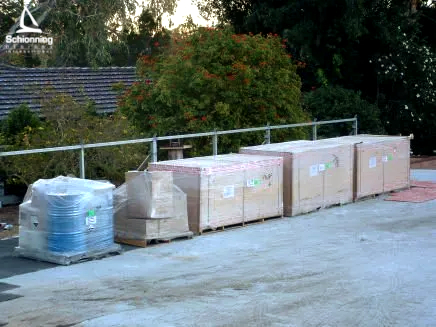
Our kits contain all of your basic materials to build your boat to a faired shell stage, ready for painting and fit-out. We have sail-away costing estimates available for all of our standard designs, and this will give you an accurate idea of the overall cost of your project. This costing varies depending on your level of finish, as you can imagine different options vary greatly in price.
Below is a quick glance at what your Schionning Kit will include and what each item is primarily used for, we hope this is helpful and if you should require more detailed information please don’t hesitate to contact our office.
What do I actually receive?
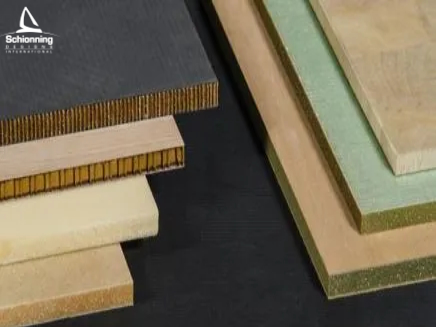
DUFLEX PRE-LAMINATED PANELS
DuFlex pre-laminated panels are the main and most important material used in our kits, predominantly in the flat panel designs, however they are used in Strip-planked designs also, though to a lesser extent. These panels are 2400mm x 1200mm and are CNC routed to speed up build time on our Wildernes X Series, as well as some of our power designs. For internal furniture, a paper honeycomb core is used instead of the end-grain balsa wood core that is used for main structural areas. The use of this is purely to save weight in the shell and therefore produce a faster, more responsive catamaran.

KINETIX LAMINATING RESIN & HARDENER

WEST SYSTEM EPOXY RESINS

FIBREGLASS TAPES (DOUBLE BIAS)
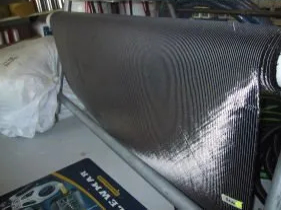
CARBON FIBRE CLOTH

FIBREGLASS CLOTH
The kit process, building your own boat can be a daunting prospect, however to demonstrate each step in the kit assembly process, we've created this guide for you to study. as you can see our kits are the ultimate in building efficiency and have been streamlined over 30+ years to ensure that you're on the water faster and with less effort., how does it all go together.
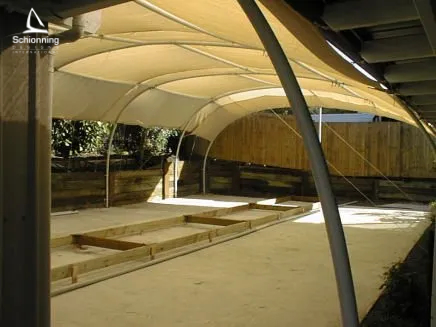
The first step to building your dream catamaran begins with a strongback – this is a square frame used to position the temporary frames that will be used to form the hull shape. This frame will be set up and must be square and accurate, a string or laser level can be used to achieve this.

The forebeam is now installed along with the striker attachment fitting, as shown above. The bridgedeck is installed shortly after and taped onto the bulkheads with webs installed, this now completes what is a quite stiff and strong platform to work on.

Now that the bridgedeck is in place, the forward webs and dash will be fitted. At this stage, all furniture and internal work begins, with the main panels left off for ease of access when working.
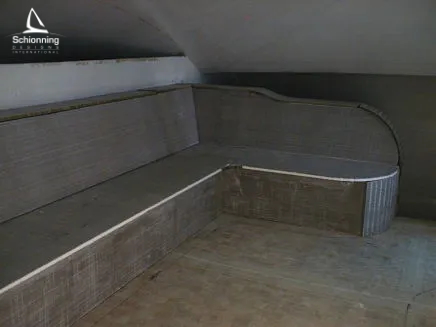
Material Choices
Schionning material choices, solutions that work best for catamarans & why, our designs are based on cored composite construction techniques using west system epoxy resin and knitted fabrics. but given the range of today's composite technologies, which solution works best for catamarans and why written by jeff schionning, selecting the correct materials, resin choices.

It also fully protects the boat against water absorption and it can not develop the dreaded Osmosis.
We choose ATL Composite’s resin systems for their superior quality, reliability and value for money.
Having worked closely with the ATL Composites team and their products for many years, we know we can stand by their material solutions, and rely on great service should something unexpected happen.

This may not seem important but when working with a material for an extended period of time, the small things make all the difference.
CORES Which One to Use?

- End-Grain Balsa – 150kg per cubic metre
- Superlight Balsa – 94kg per cubic metre
- Western Red Cedar – 360-380kg per cubic metre
- Foam – 80kg per cubic metre
BALSA END GRAIN (150 kg/cubic metre)
Balsa has very good values and we can produce a shell using a very light laminate. It will be very stiff and very resilient to fatigue.
It has exceptional qualities including very high compression strength, extremely good sheer capabilities and fantastic sheer stiffness.
Compressive strength is the resistance to collapsing when pressure is applied perpendicular to the surface as when pushing directly onto the material with the point of your finger. Balsa is far stronger than Foam (80kg/cubic metre) in compression.
Balsa is also very strong in shear. This is when the core sample is held flat between your hands, one hand slid one way and the other slid the opposite way, when the core tears through the middle the core has failed in sheer. The amount of stretch you feel before the core shears is shear stiffness. To compensate for sheer weakness the core is made thicker. So 13mm Balsa may be equal in sheer to 19mm Foam.
(80 to 200 kg/m³)
There are many boats sailing that are built from foam as it’s mechanical properties are good for boat building.
- Initially one would expect this cat shell to be lighter as it is ½ the weight of Balsa. We do have to compensate for its weaknesses and will then add to the reinforcement the reinforcement on the outside to spread that compression load over more core and need a triaxial type weave to compensate for the veneer content that runs fore and aft on the Durakore.
- Secondly, we need to increase the Core thickness to compensate for the shear value, usually neutralizing the weight advantage.
- We only use structural foam core that is closed-cell and cross-linked.
The end result using foam core amounts to a very similar total boat weight. Professional builders can achieve a good result but usually use vacuum bagging and very good molds to achieve this.
Secondary Issues
Balsa can absorb water. It needs extreme neglect to rot (very unusual). Water soaks along the end grain quickly. It travels very slowly across the grain. We use balsa under the waterline especially because of it’s high compression strength for beaching etc. any core type must be sealed. Damage to all cores results in the same sort of repair. Notice a damp spot remaining when drying out to anti-foul… simply grind back the surface glass exposing the core, dry it out and re-glass – it’s that easy.
Timber cores are cheaper than Foam in most cases.
A light, high tech cat returns a far better (often 2 – 3 times) re-sale than lower tech materials. Often saving $10,000 on materials initially, loses $200,000 on re-sale – a serious reality.
Our boats can be built using Balsa, Foam or Western Red Cedar. Combine strength, stiffness, lightness and cost, with ease of use – it just makes good sense!
HOME / INDEX PAGE
Projects: Constructing a 40ft catamaran with WEST SYSTEM epoxy
Work doesn’t necessarily slow down after retirement, as engineer Martin Ellison proved when he left his teaching post at the age of 59 and set about building his first boat. What started as some prompting from his wife to find a meaningful project evolved into the idea of building a 40ft catamaran. Martin tells epoxycraft how it all came about.
I have always loved being on or near the water and wanted to have a boat of my own. As someone who has renovated a few houses in the past, I wasn’t daunted by the idea of building a wooden boat from a set of plans, although I’m not sure it was the scale of project my wife had in mind!
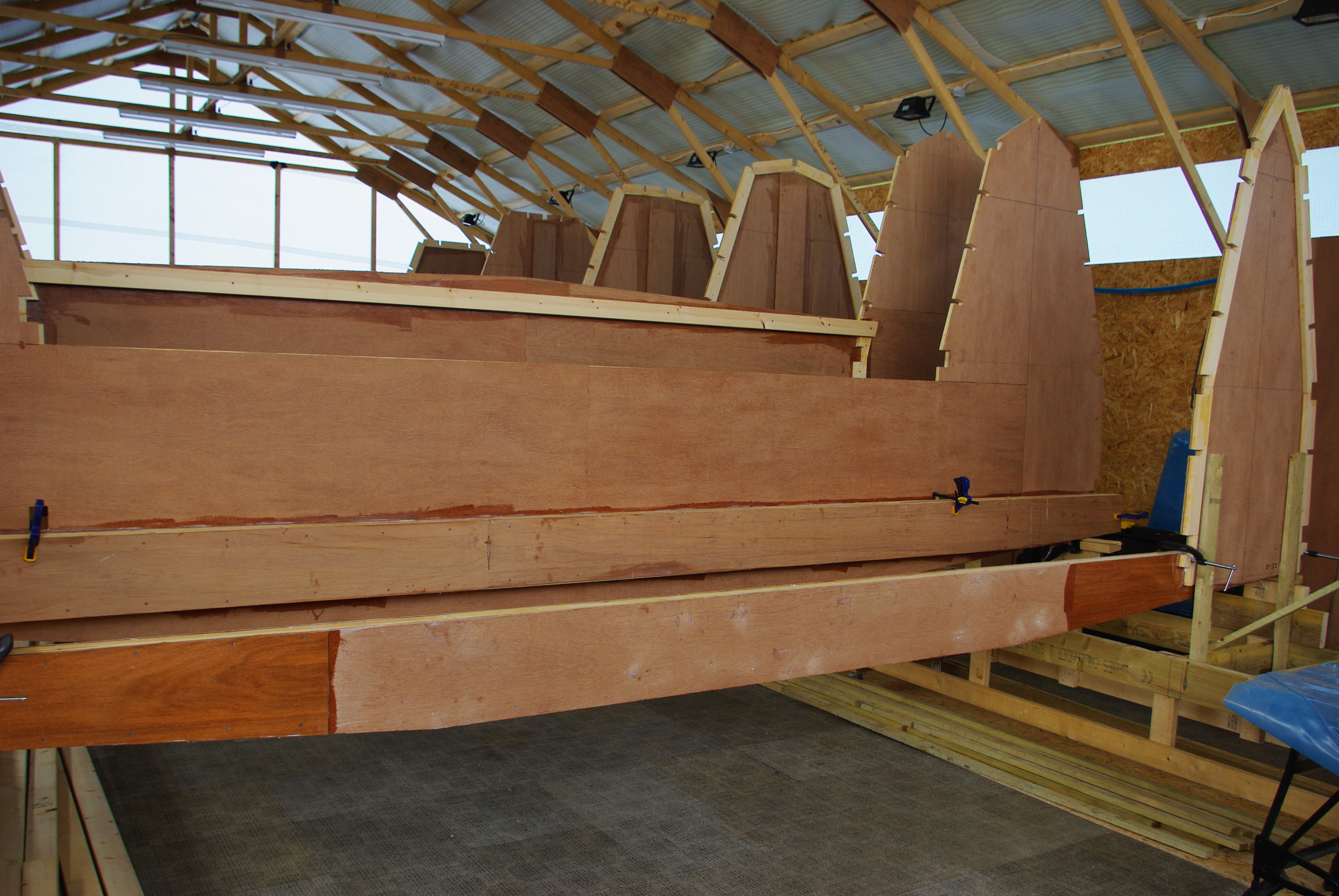
I chose to build a catamaran because I wanted the space and stability; preferring a power cat, I searched online for some designs and went for the Skoota 36 ( Woods Designs ). This is a relatively simple timber and plywood design sheathed in fibreglass, although I have slightly modified the design to increase the length to 40ft so that I could enlarge the accommodation space in the hulls.
When I began in earnest in September 2014 I didn’t even have a boat shed, so that was the first project. It was ready for action by March 2015 and I have been steadily working on the boat for the past nine months.
I’ve used WEST SYSTEM epoxy all over… and found its strength and versatility to be ideal.
For the build I’ve used WEST SYSTEM® epoxy all over – jointing, filleting, waterproofing and sheathing and have found its strength and versatility to be ideal for this project.
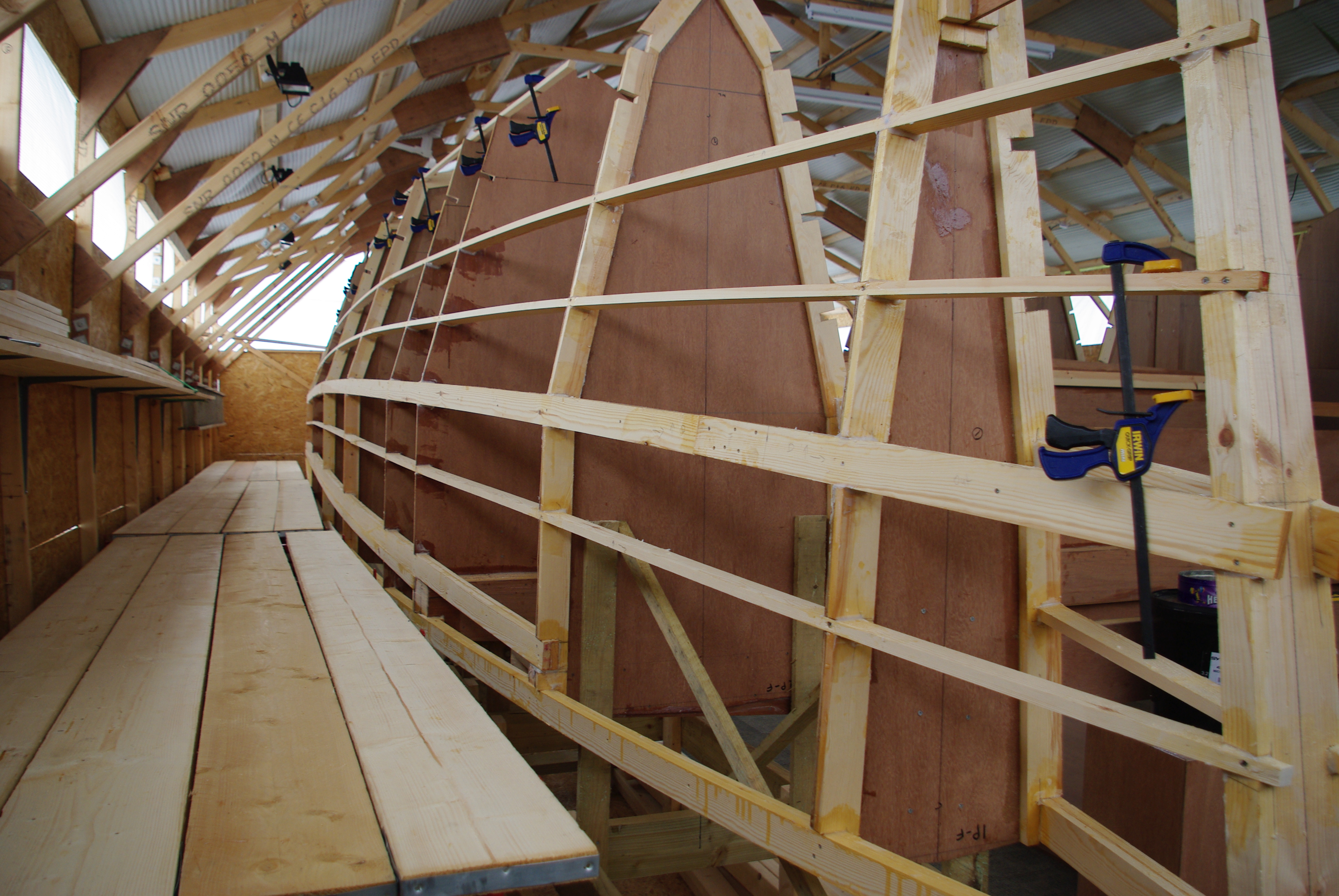
I’ve mainly used WEST SYSTEM 105 Epoxy Resin® with WEST SYSTEM 205 Fast Hardener® . In addition, I’ve combined the epoxy mix with WEST SYSTEM 403 Microfibres and WEST SYSTEM 409 Microsphere Blend® to ensure all the gaps have been thoroughly filled. When it came to sheathing, I used 300g and 600g Episize™ Biaxial Fabric and 300g woven WEST SYSTEM 787 Aramid Fabric® to provide extra protection below the waterline.
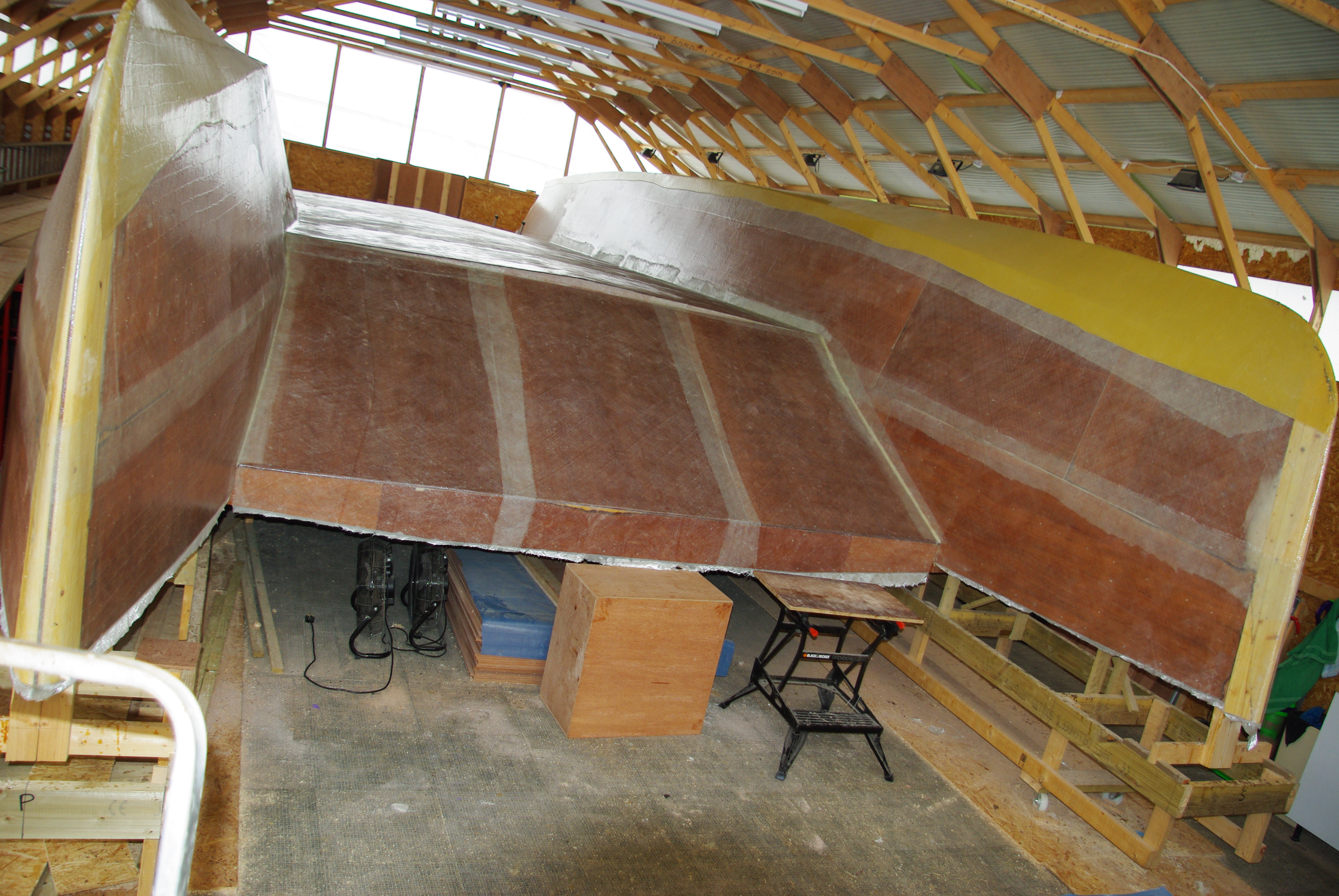
The boat build so far has taken just over 1100 hours. It’s a big boat and there’s a lot of work – mainly woodwork – involved in completing each stage. I’m enjoying it though, it’s very rewarding and most of the build has gone pretty smoothly.
As luck would have it there is another Skoota 36 being built in Canada which is about one year ahead of me and the owner has very kindly shared his build photos, which has been a great help. People say it looks very difficult but in practice it isn’t – it’s simply a case of following the plans and having the confidence to get on with it.
There’s still a bit of a way to go but I’m really looking forward to turning over so we can finalise the internal layout and then getting her in the water and cruising in her.
Our thanks to Martin Ellison for sharing his story. We wish him well and will be following him closely as he completes his build.
If you would like more information about this project you can follow the build on https://my-new-cat.weebly.com
Back to projects

Lochaber Coastal Rowing Club and the St Ayles Skiff Project

Life Aboard Speranza
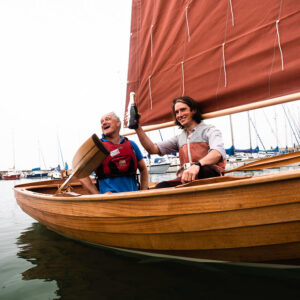
A Journey into the Boat Industry
TRI-STAR 24
Tri-star 25.
TRI-STAR 25 Study Plans $40.00 Add To Cart TRI-STAR 25 Plans $550.00 Add To Cart
TRI-STAR 26 MT
Tri-star 27-9, tri-star 31, tri-star 31 cm.
TRI-STAR 31CM Study Plans $40.00 Add To Cart TRI-STAR 31CM Plans $600.00 Add To Cart
TRI-STAR 32 XR
TRI-STAR 32XR Study Plans $40.00 Add To Cart TRI-STAR 32XR Plans $600.00 Add To Cart
TRI-STAR 35
TRI-STAR 35 Study Plans $ 40.00 Add To Cart TRI-STAR 35 Plans $ 650.00 Add To Cart
TRI-STAR 35 XR
TRI-STAR 35 XR Study Plans $40.00 Add To Cart TRI-STAR 35 XR Plans $700.00 Add To Cart
TRI-STAR 36
Tri-star 37 xrc.
TRI-STAR 37 XRC Study Plans $ 40.00 Add To Cart TRI-STAR 37 XRC Plans $ 800.00 Add To Cart
TRI-STAR 38 / 39
Tri-star 40 lw, tri-star 42, tri-star 43 xrc, tri-star 43 mc, tri-star 44 lw, tri-star 45, tri-star 49, tri-star 50, tri-star 51 mc, tri-star 54, tri-star 60 / 63, tri-star 65, tri-star 80, tri-star 104.
Email us for availability and prices

- Plans & Kits
- Plans by type
ECO 55 Power Cat Plans
Write a review.

- Create New Wish List
Description
Additional information.

The ECO 55 power catamaran is an affordable DIY power catamaran. As the owner proved the boat is a capable coastal cruiser. The inside layout is the same as for the ECO55 sail version but the underwater shape is changed. The cockpit is wider and has a size of 1,45m x 2 m. With the bigger size normal deck chairs can be used. With a cockpit cover two more can sleep on the boat.
Accommodation is simple but practical.

Because of the easily driven hulls the boat will travel at about 12 knots with the a 15 HP outboard engine. But practice showed that a single outboard of 20 HP is more feasible - less noise and lower operating costs.

The boat has a double bunk, but the cockpit is big enough to sleep 2 more persons. The construction and list of materials is similar to the ECO55 sail version . The difference is that you need no rig, rudders or dagger board. With the low weight of about 325 kg including engines the boat can be towed behind a relative small car.

Construction is as always the plywood/glass/Epoxy construction system. The hulls are V-shaped with vertical sides - easy to build by a beginner. For cost estimation see the list of materials below.
- All drawings are CAD drawings
- Wood/epoxy composite for easy construction and low maintenance.
- Sleeps up to four
DELIVERY: 16 Drawings: JPG or DXF files. + Manual: 12 pages description (PDF)

Related Products

ECO 75 Power Cat Plans

ECO 55 Sail Plans

New ECO 55 Sail Plans

Skoota 18 Power Cat Plans PDF
- GRAINGER DESIGNS
Raku Sailing Catamarans

From 32' to 66' LOA . We've designed these elegant high performance cruising cats for fast efficient construction from Panel Kits. More details here:

At 78' LOA with luxury accommodation for 12 guests in 6 cabins with en-suites, this is the premier model in the Sensori Power Cat Range.

Above; 42' custom trimaran "Venom" See the Trimaran Pages here
Join the Newsletter

- Scroll to top

James Wharram Designs
Search Our Site
- Self Build Boats
- Professionally Built Boats
- Choosing a Boat
- How We Design
- Photo Gallery
- Video Gallery
- Articles & Blogs
- Wharram World
Tiki Designs
Coastal trekkers to long term live aboards.
From the car trailable Tiki 21 - winner of the 1982 Cruising World Design Competition, to the Tiki 46, a spacious ocean cruiser or charter boat, the TIKI range offers car trailable coastal trekkers to long term live aboards. Although a Tiki 21, a very popular coastal trek design, has circumnavigated, we would not recommend this for everyone! A number of Tiki 26s have also made ocean crossings, but again this is only for the experienced sailor. The larger TIKI designs of 30ft and over are craft capable of longer voyages and ocean crossings. They are designed to be less costly to build by using appropriate wood/epoxy technology and by eliminating, wherever possible, expensive metal fittings common to modern yacht design.
On the larger TIKIs the 'Deckpod' offers sheltered steering and the 'Stern Ramp' provides easy access to and from the water. The TIKIs are boats you can work and live on. The Wharram approach goes beyond simple boat design - the concept of 'Flexispace' puts emphasis on not just the physical living area, but also the 'mind space' of those on board.
About Tiki Building Plans
The TIKI Building Plans, designed from the early 1980s till the present, represent a new phase in our presentation of building drawings. The first small Tikis were all built in stitch-and-glue ply and epoxy. This needed a different way of guiding the builder through the build process, as the boats are built shell first, instead of frame first. All TIKI building Plans are very detailed, which some builders have described as a course in boat building . They supply a building sequence as a book of large 3D drawings of all the plywood parts and overall construction details, drawn to scale. Some parts are given full size, to be copied on the plywood.
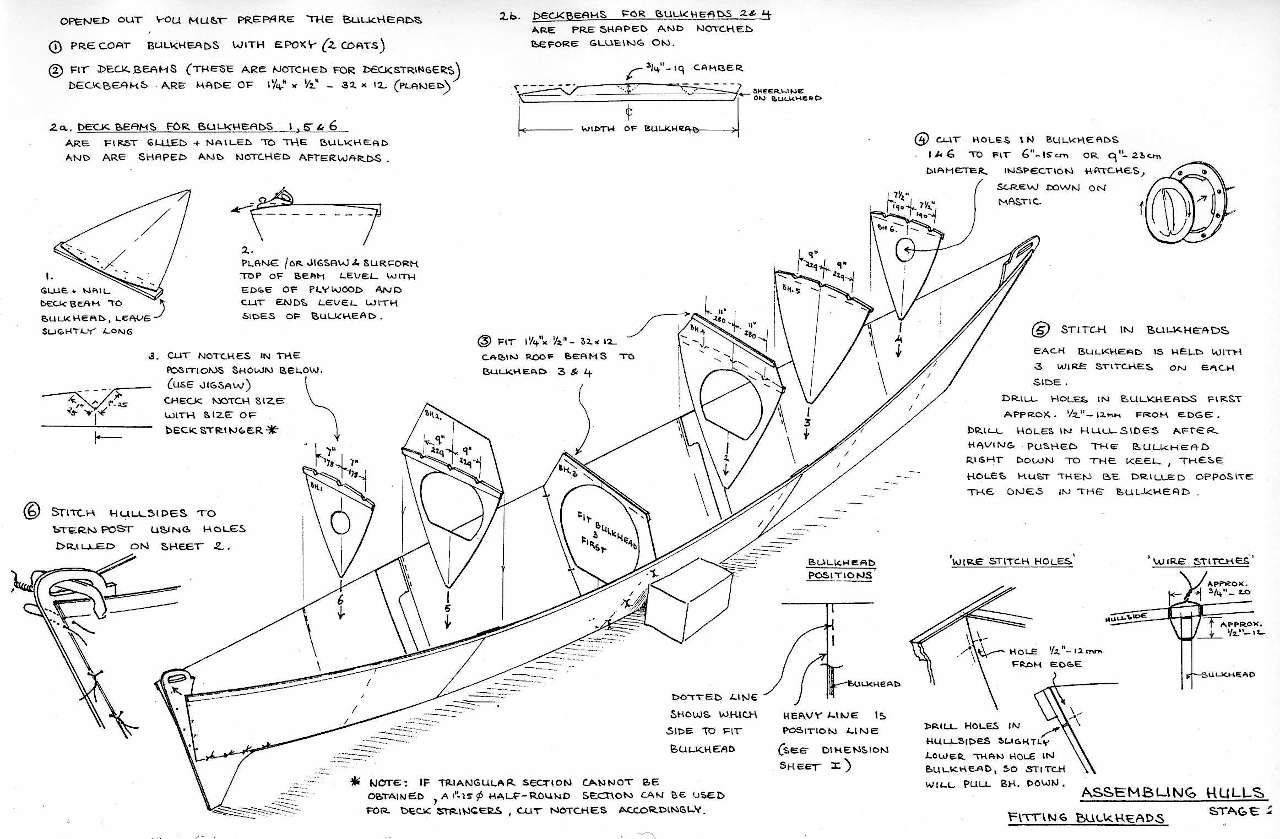
These scale drawings are accompanied by an A3 size sketchbook, which leads the builder step by step through the build with beautiful detailed sketches and numbered sequence of construction. They are all hand drawn by Hanneke, who has years of hands-on experience of building and designing Wharram catamarans. All our practical expertise, with a focus on keeping things simple, has gone into these drawings. These sketchbooks have made it possible for people with no boatbuilding experience to build a beautiful boat .
See information about building costs .

The Tiki 21 was designed in 1981 as an easy to build Coastal Trek catamaran, using new epoxy/glass stitch & glue techniques. In 1982 the new and then quite radical Tiki 21 was given first prize by Cruising World magazine (USA) in their design competition for a 'Trailable Gunkholer'. Since then nearly 1000 Tiki 21 Plans have been sold (2015).
In 1991-97 Rory McDougall sailed his self-built Tiki 21 'Cooking Fat' around the world, sometimes alone, sometimes with a companion. She was, and still is, the smallest catamaran to have circumnavigated . In 2010 Rory entered 'Cooking Fat' in the Jester Challenge (single handed 'race' across the Atlantic for small boats - under 30ft) and came into Newport, Rhode Island a close second after 34 days.
The Tiki 21 has stayed popular as a simple, easy to trail Coastal Trekker all over the world. Her unique soft Wharram Wingsail Rig has been used on all subsequent Tiki and other Wharram designs (30ft - 65ft) and is very popular with the owners of these boats.
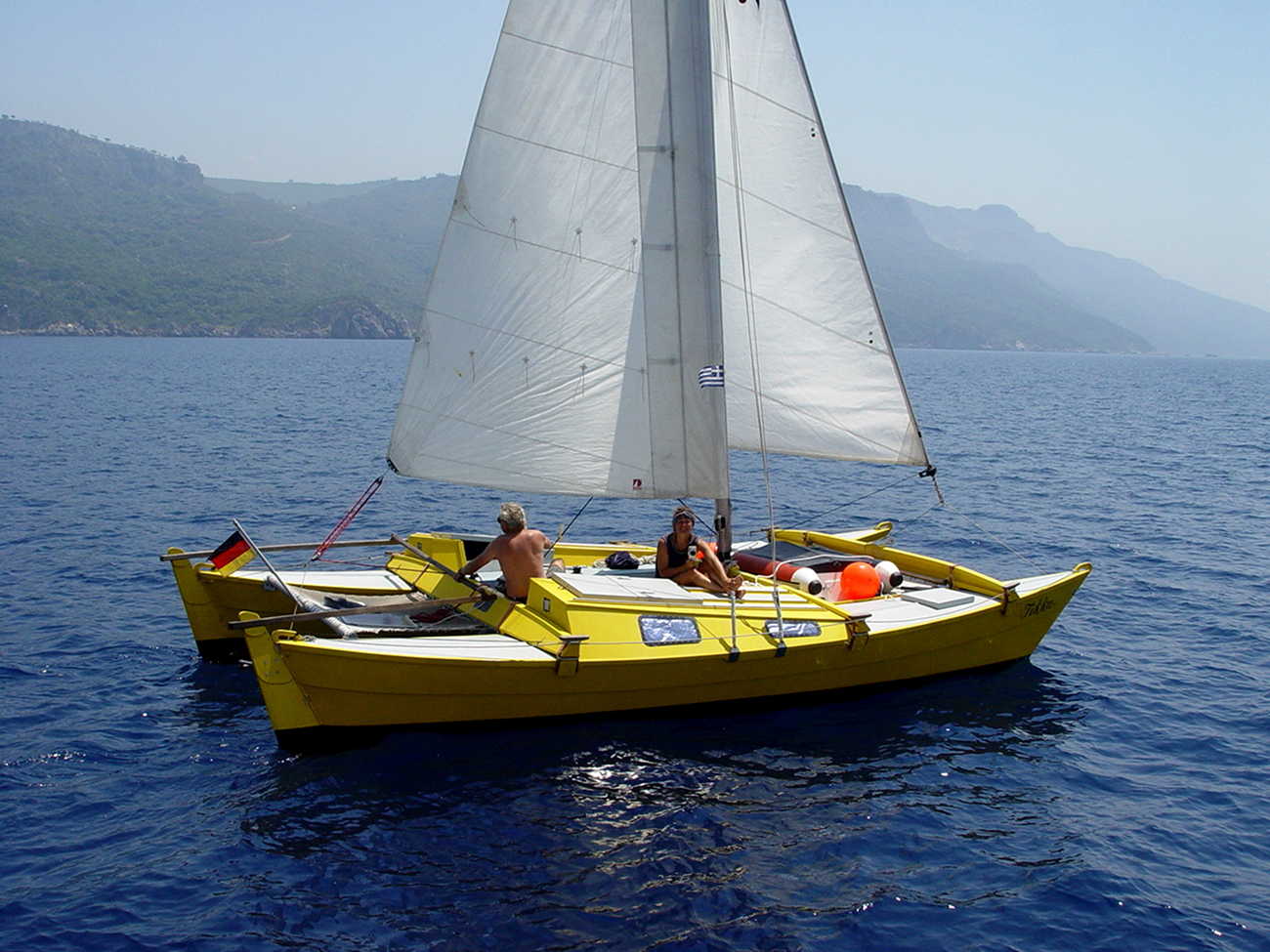
The Tiki 26 was designed by popular demand soon after the Tiki 21, for people who wanted to do more serious Coastal cruising. Her ocean going abilities have since been proven in various ocean crossings .
The Tiki 26 can be trailed and is easily beached, to step off in ankle deep water. Sleeps two in the hulls, leaving room for small galley and chart table, but accommodation can be increased with a decktent, giving space for a double bunk.
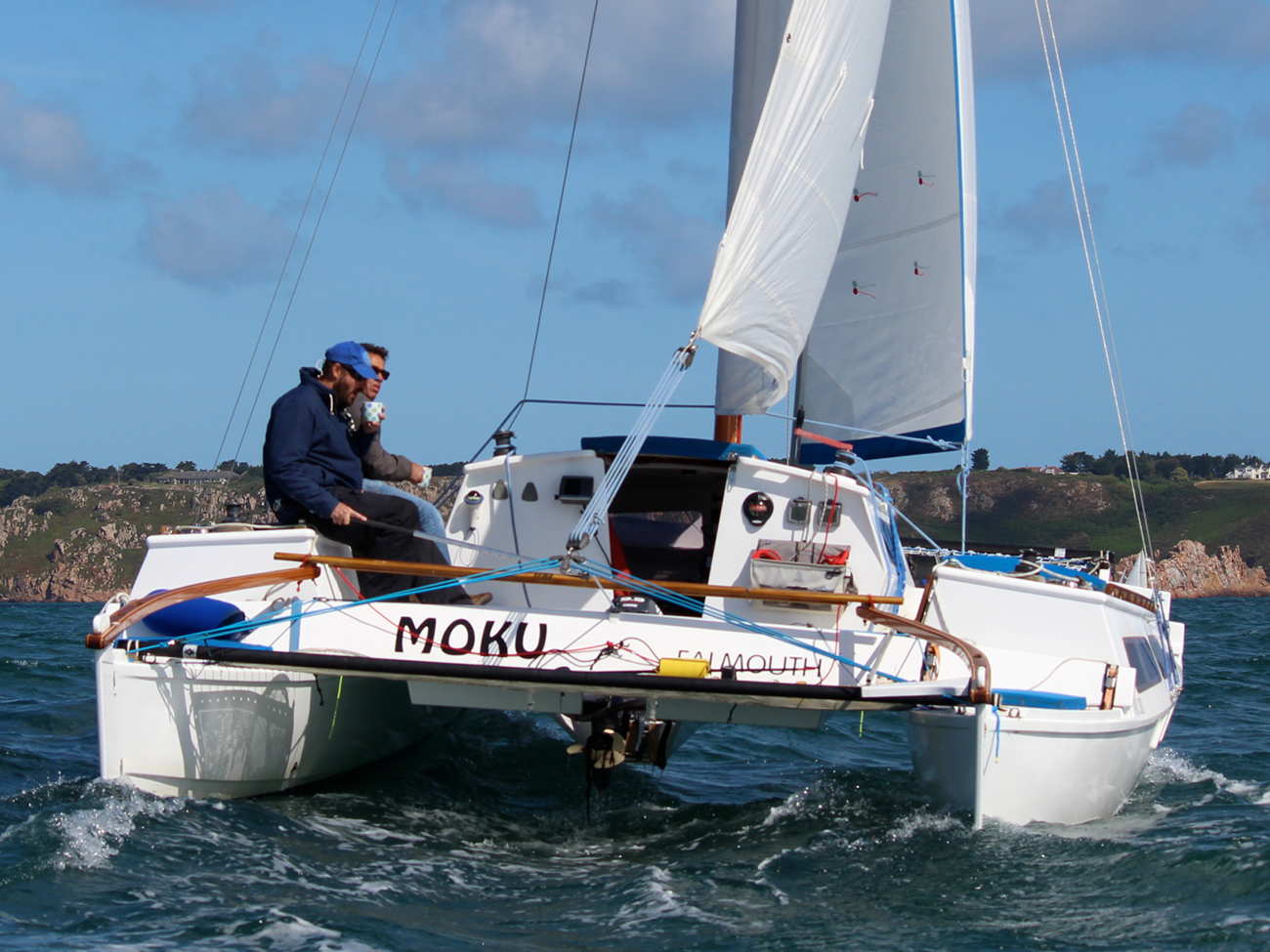
The ideal low budget self build ocean cruiser. With a sleeping capacity of 6 (two doubles in the hulls) and spacious level deck area, TIKI 30 makes an excellent low cost charter boat.
It is our largest self-build boat design that is capable of being towed behind a vehicle . This means keeping the build weight down, and simple but adequate accommodation. This is not a high cost, luxury boat, but an elegant, versatile, 'double canoe' sailing boat, providing basic comfort for 'Living on the Sea'.
An optional deck pod with double berth and/or navigation station is available. This pod replaces the standard open cockpit.
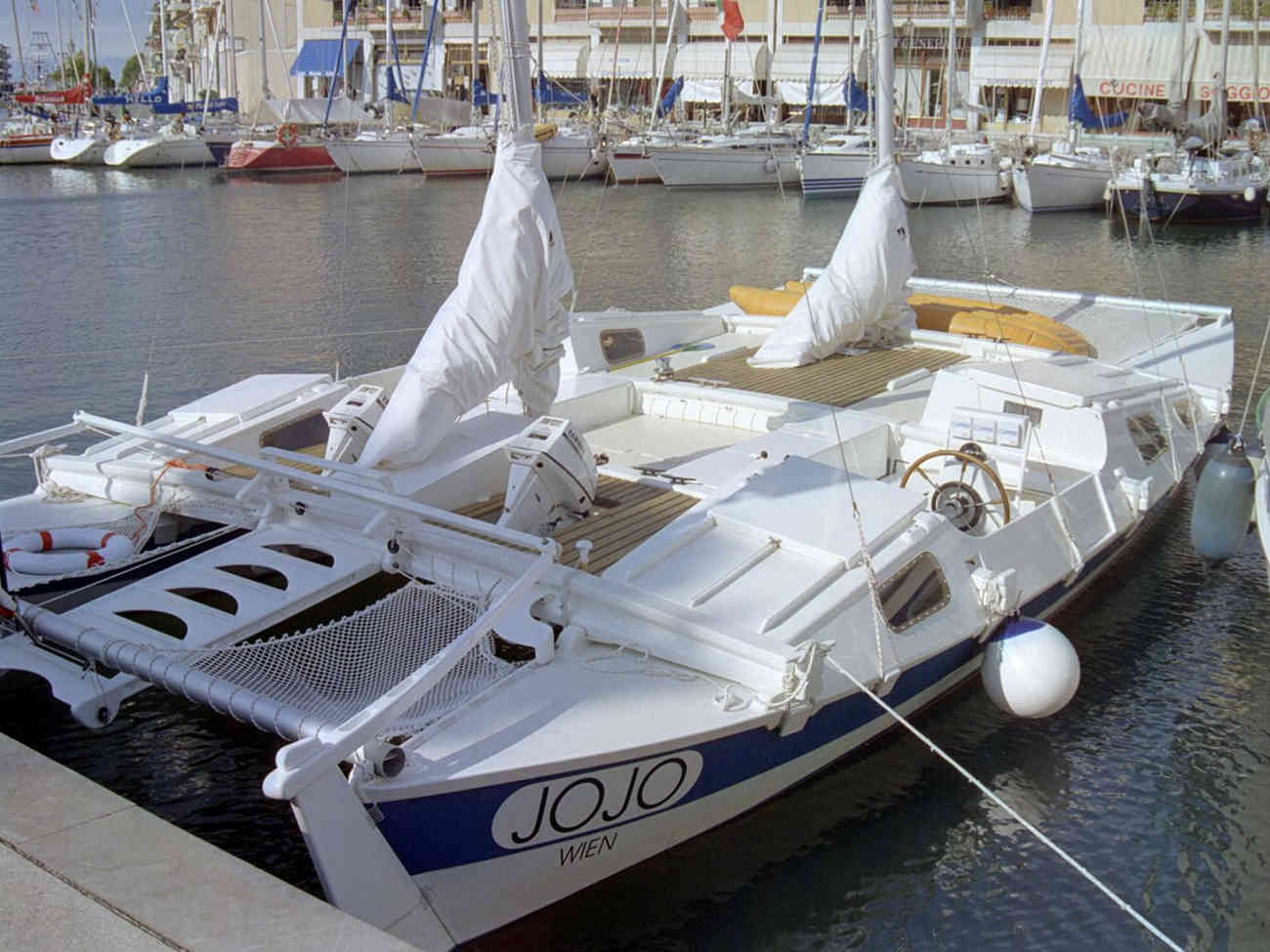
A traveller/workboat with ramp access at stern. She has open hull cockpits with removable tough awning covers, ideal for fishing . For workboat use she has a Wingsail schooner rig, with two short masts. Can sleep 4-6.
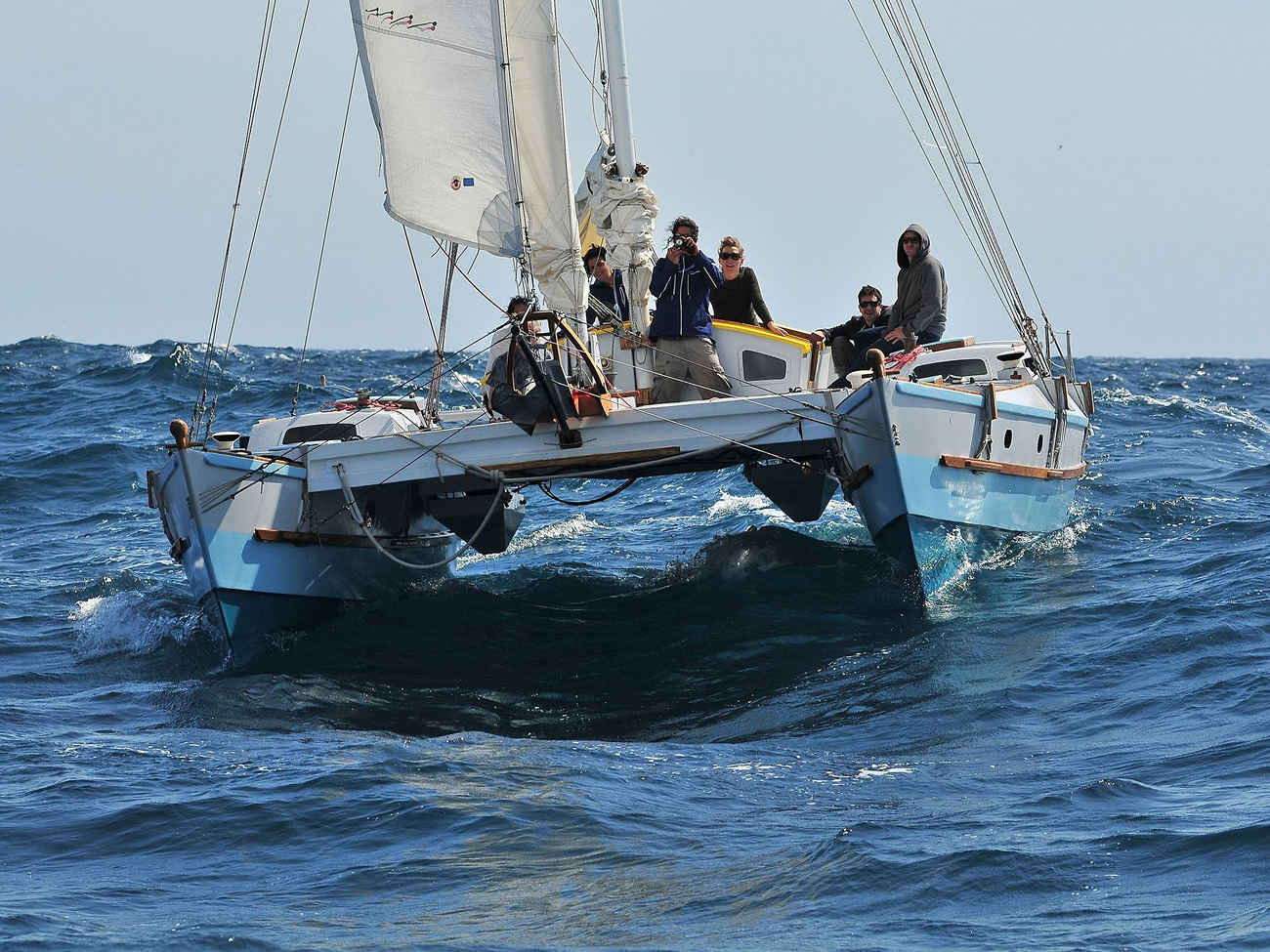
The TIKI 38 was designed using all the latest Wharram construction innovations. Her deckpod gives good shelter when ocean cruising and includes a bunk for the off-watch crew. Forward of the deckpod is 26 Sqr metres of safe, usable deck space. An excellent family cruising boat .
The TIKI 38 interior comprises two double cabins, two single cabins, galley, navigation station and toilet/shower, as well as good storage areas in bow and stern.

The Tiki 46 is a boat designed for Blue Water sailing , with live aboard space for a crew of up to 10. She also makes an excellent charter vessel with 4 private double cabins and an extra double in the deckpod. Plenty of safe deck space and slim hulls for easy, fast sailing, not requiring huge sail area to get speed.
Anne and Neville Clement write logs about their voyages on self-built Tiki 46 'Peace IV'.
Questions about Tiki designs? Contact us:

Tokyo Express
- Small Boats
- Geelong Model 850
- Plans (all)
- Noosa Plans
- Tewantin Plans
- Geelong Plans
- Daggerboard Plans
- Daggerboards
- Consulting / Drafting
- Terms & Conditions
- Privacy Policy
Select Page
Catamaran & Small Boat Building
to my website. Here you’ll find photos, stories and information on building boats large and small, with tips and tricks I’ve picked up along the way. I built this website originally to accompany my YouTube channel . The blog section has information on various topics.
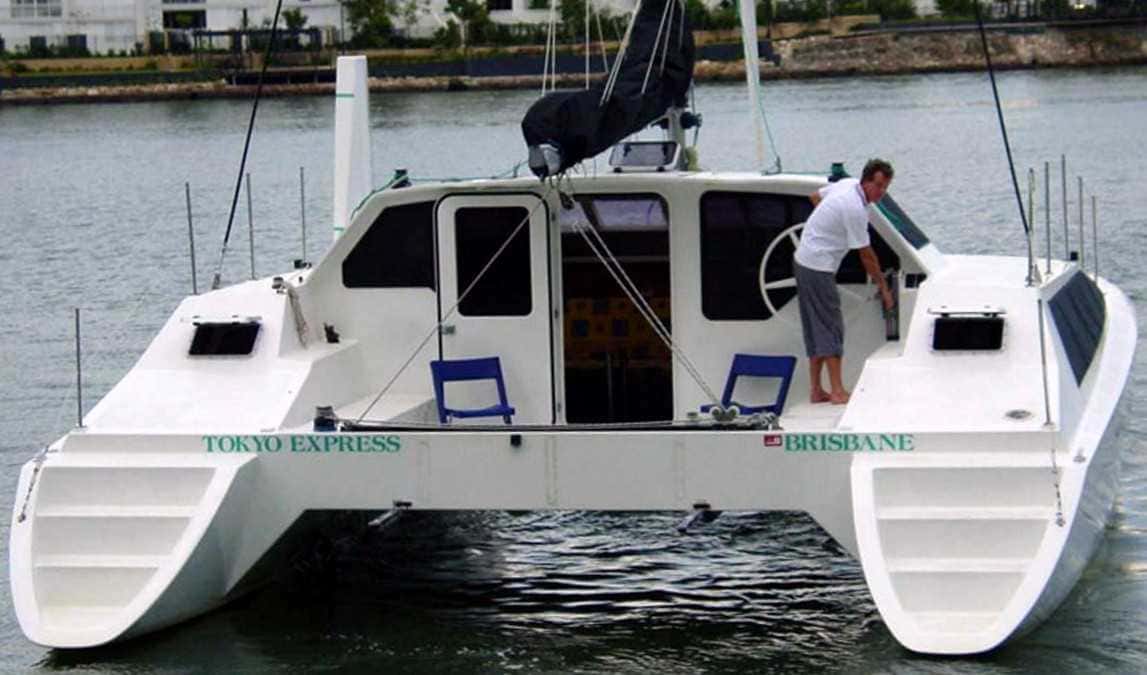
A 12m cruiser/racer catamaran – 2 yrs & 9 mths to build – launched 15th August 1997. Details of the build.
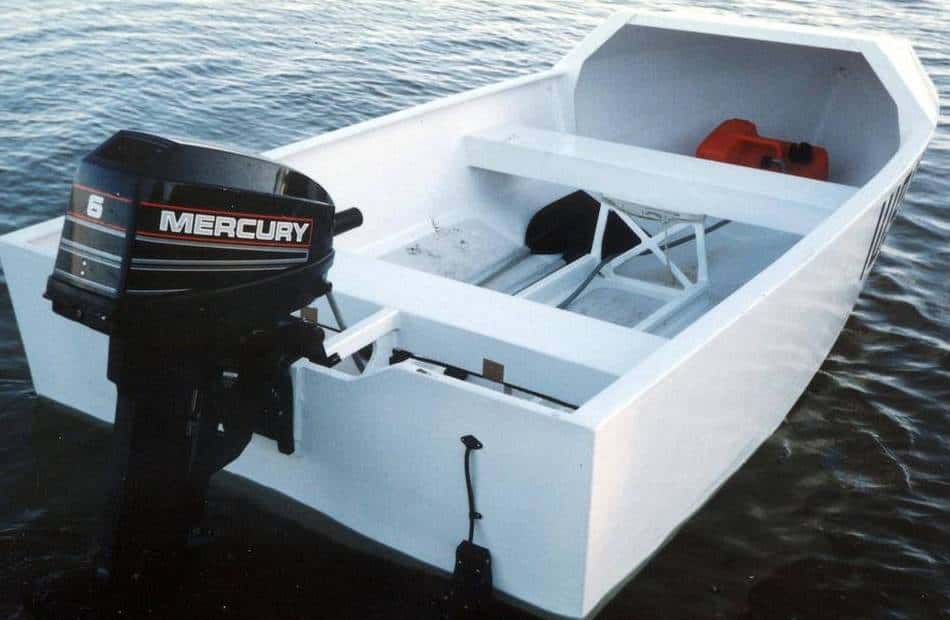
Small boats
Small boats you can build in your garage. A good family project and a way to get a taste of boat building. See how they were built.
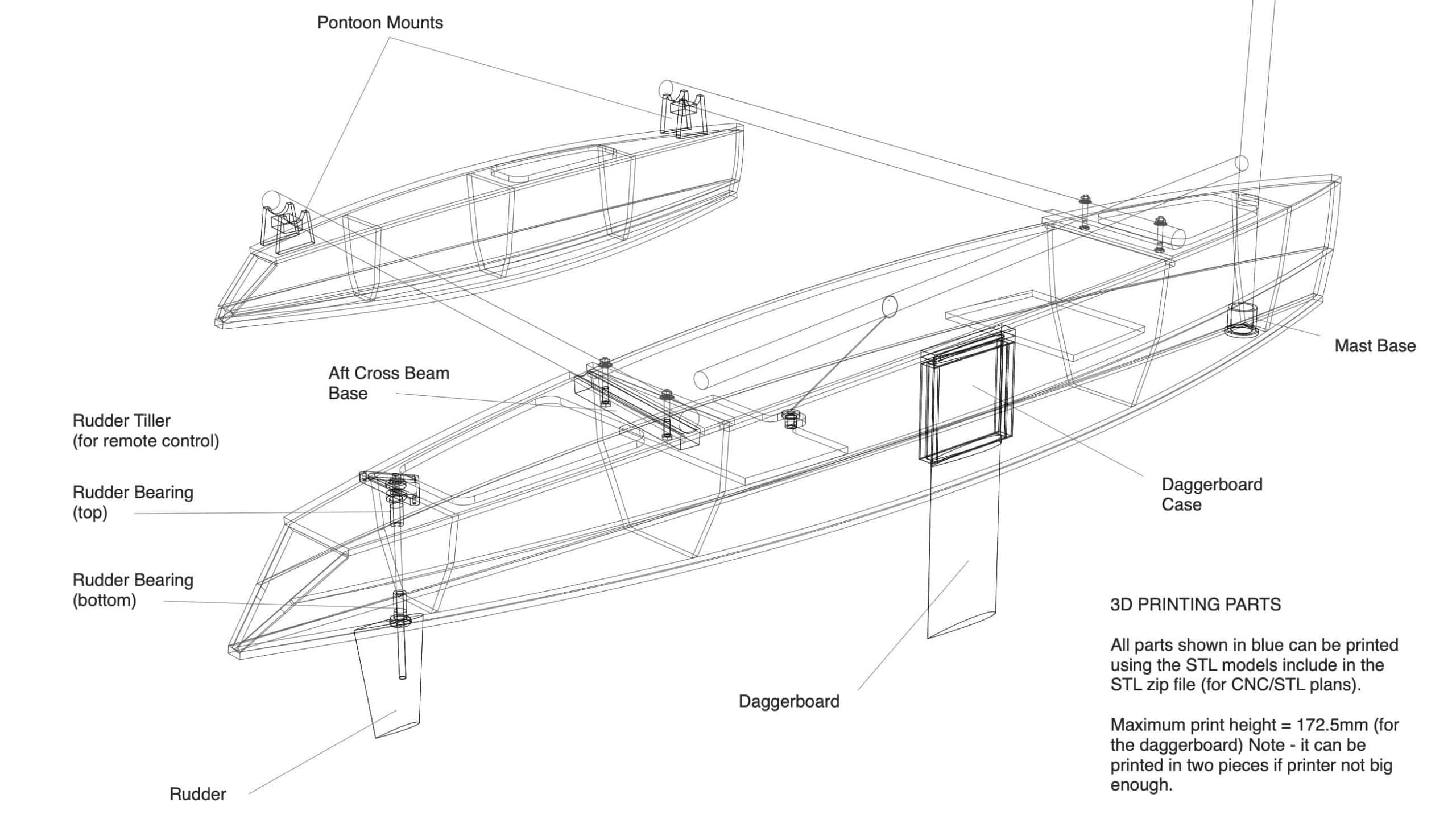
Plans to build your own boat. Packed with information for the first time builder. Start building your boat now.
Where to start
Building your own boat and sailing off over the horizon, is a dream that lives inside many. Well at least that’s the impression I get from the many people I met while building Tokyo Express (TE) and the feedback now f rom the videos on YouTube. After years of dreaming, at 39 years of age I finally turned that dream into reality with the launching of Tokyo Express. This website is about my journey.
You don’t need expensive kits
or exotic materials to build a boat. You don’t need expensive tools or a degree in engineering either. I fabricated most of the parts and systems on Tokyo Express (TE) from scratch. Steering system, steering wheel, doors, hatches, fore beam, catwalk, daggerboard, rudders, engine mounting, generator, electrical system and plumbing.
Even the mast I bought as a kit. I had more time than money so I built everything I could. There were no exotic materials used and yet I ended up with a robust, lightweight and extremely competitive boat that was lighter than a typical production boat.
If I hadn’t been designing and redesigning many parts of the boat, learning for the first time how to do things and building a shed, the boat would have been finished a lot quicker.
On the Tokyo Express page
page you will find an overview of the steps I took building TE. If you are thinking of starting a similar project, this is a good place to start. It was a lot of work, but it was also the most rewarding project I have undertaken. It was well worth the sweat and tears. Please look around. Email me if you have questions…
Recent Posts
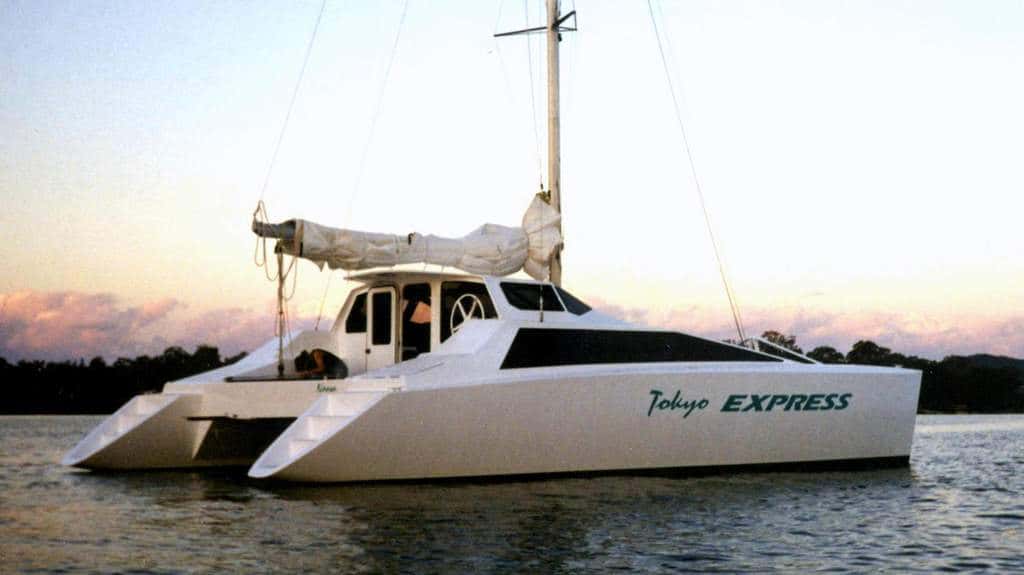
- Catamaran vs Monohull
by Tim Weston | Mar 11, 2019 | Building , Cruising
Catamaran vs Monohull If you are thinking of building or buying a yacht, you have a significant choice to make, before you even start looking at individual boats. Do you want one hull or two? Deciding between a catamaran and a monohull is a big decision and one worth...

- Going fast – in small boats – hull speed.
by Tim Weston | Sep 30, 2018 | Building , Plans
Going fast - in small boats (with a small motor) This article looks at how to go fast, in a boat with a small motor. Plodding along at snail’s pace can get a little boring. No matter how relaxed I am and how much time I have nothing puts a smile on my face quicker...
Search Site
New book – just released.
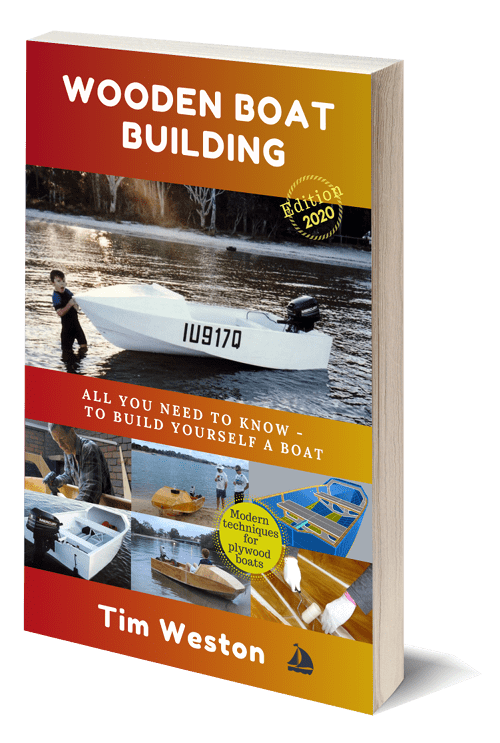
Watch the Video Series – (1 hour & 45 mins)
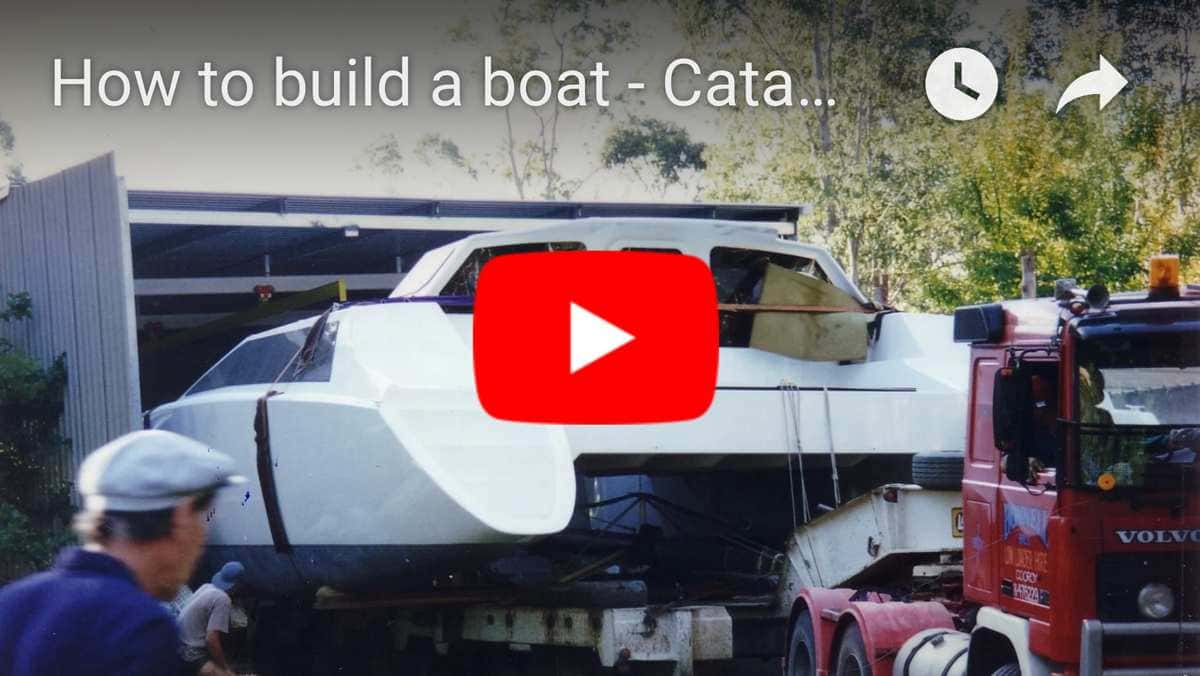
- Keeping safe – while building your boat
- Catamaran size – how big a boat do you need – ocean sailing
- How much does it cost to build a boat – a 40ft Catamaran?
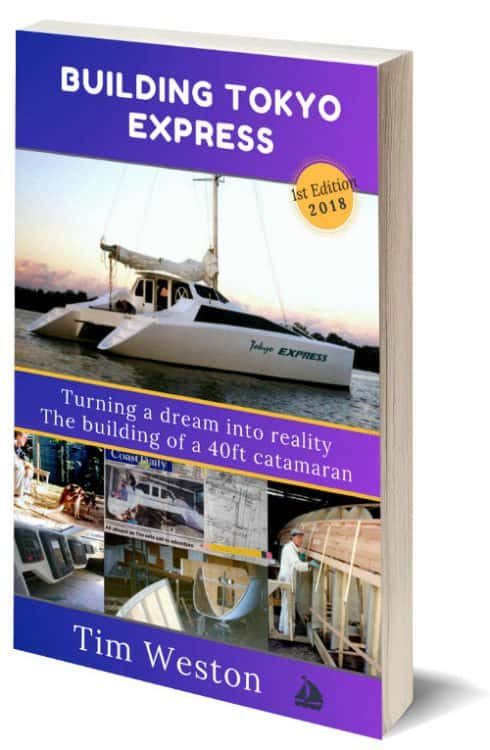
Get the Guide – Free
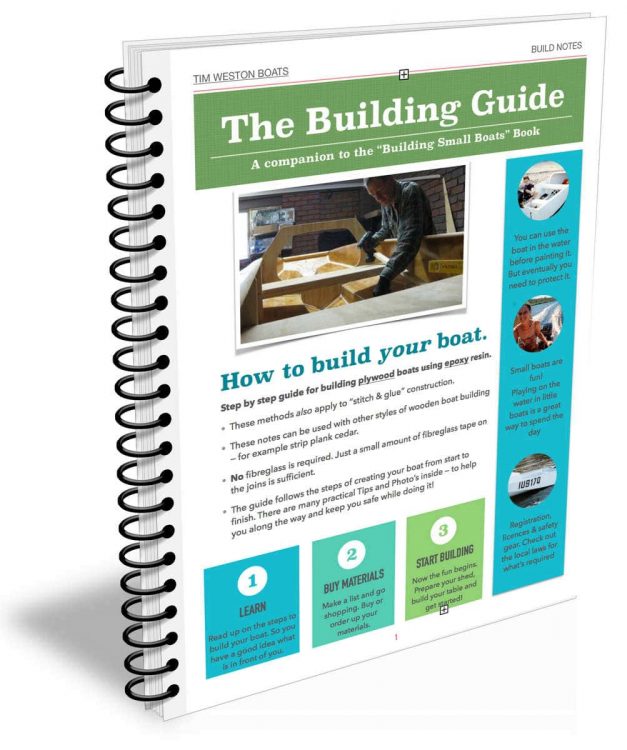
Tim Weston Boats
2022©timwestonboats.com
[email protected]
Privacy Overview

IMAGES
COMMENTS
To build a DIY cruising catamaran, buy good design plans, determine your budget and find a working space. Next, choose your hull material, buy supplies and start building the mast beam. Build and sheathe the hull, install bulkheads, the interior, and finally, launch the catamaran boat.
We provide stock boat plans for both monohull and multihull sailing vessels, including sailing skiffs and sharpies. Our designs mainly feature timber construction, in plywood or cedar strip plank composite construction, using the W.E.S.T. system (wood epoxy saturation technique).
CAT 34 CAT 34, designed as a mid-size comfortable, quick sailing catamaran with comfortable accomodations, a spacious bridge deck lounge area that has 6ft of headroom. Click for more information TRI-STAR CAT 34 Study Plans $ Add To Cart TRI-STAR CAT 34 Plans $ Add To Cart CAT 36
$ 170.00 - $ 185.00 (USD) Lively 35 Cruising Trimaran $ 355.00 - $ 370.00 (USD) Catamaran & Trimaran Boat Plans from Hartley Boats make it a reality to build your own multihull at home. Build with Plywood or Fibre Glass. 12-35 ft plans.
Catamaran Plans: Design, Build and Sail your own Multi-Hull Boat Why Build a Catamaran: The Benefits of Multi-Hull Boats Designing Your Own Catamaran: Tips and Tricks Materials and Tools Needed for Building a Catamaran Common Mistakes to Avoid When Building a Catamaran Finishing and Launching Your Catamaran
Everything you need to build your own sea-going catamaran: 3 steps Familiarise yourself with our range of designs and their unique qualities. For more detailed information read the Wharram Design Book which reviews each self-build boat model and offers a detailed introduction and understanding of the world of self-build catamarans.
Besides illustrating my stock designs, for which I sell study plans and full construction plans, it also contains my design philosophy of multihulls; an article on the rapid Cylinder Mold (pdf) or Cylinder-molding (in html) multihull construction; examples of drawing sets; photographs; fact sheets with dimensions and pricing; professional builde...
The download studyplans cost GBP15.00 Paper studyplans and plans are only available to special order. They come at a much higher cost due to printing and postage costs. Please contact us if you wish to order paper plans. You can download a sample pack of drawings (sheets from 7 different designs) HERE Read More...
Our build in 3-minutes Be Inspired - Build a Catamaran Launch Day Many sailboat plans to choose from. Is it cheaper to build or buy? There are many yacht plans to choose from, but dont kid yourself. Many have tried to do it on the cheap and their result shows. If there was a cheaper way, the sailboat designers would tell you.
Fast forward through 3 year's work - in 3 minutes, the building of a 40ft catamaran.An overview — building a DIY homemade 40ft catamaran.
Building your own boat with Wharram Designs is the easiest and most cost effective way to fulfil your sailing dreams. Wharram Self-build boat plans start from only £120. Wharram designs are based on years of practical, hands-on experience of building and ocean sailing catamarans.
Our construction plans and kits are sold with 100% professional boatbuilder support via phone and email, any time you're unsure or just need a second opinion, we're here. ... Tags: Balsa end grain catamaran material wood (150 kg/cubic metre), blue design, bluedesign, Build a boat, build a catamaran, Build a Catamaran Resin Choices, build a ...
Wharram Shop Boat Building Plans Study Plans Books DVDs Merchandise Papers and Articles Limited Edition Complete, clear and detailed plans to build your own Wharram Catamaran, that have often been described as a 'course in boat building'.
"PLANS" NOW FREE! Click here to download TCP #75 where you will find the drawings and more photos Think it can't be done? The builder claims about 900 hours to build and he has done enough of them to know. His first one was in the seventies. The ply is covered in glass and vinylester underwater and topsides and most deck.
Our power catamaran Boat Plans, Full Size Patterns and Cutting Files all feature simple & easy to follow STEP by STEP CONSTRUCTION details for ALUMINUM & FIBERGLASS boat building methods. These POWER CATAMARANS can be built by any person with welding skills (Steel or Aluminum) or general handyman skills (Fiberglass).
In addition, I've combined the epoxy mix with WEST SYSTEM 403 Microfibres and WEST SYSTEM 409 Microsphere Blend® to ensure all the gaps have been thoroughly filled. When it came to sheathing, I used 300g and 600g Episize™ Biaxial Fabric and 300g woven WEST SYSTEM 787 Aramid Fabric® to provide extra protection below the waterline.
Click for complete details TRI-STAR 25 Study Plans $40.00 Add To Cart TRI-STAR 25 Plans $550.00 Add To Cart TRI-STAR 26 MT Click for complete details TRI-STAR 26 MT Study Plans $40.00 Add To Cart TRI-STAR 26 MT Plans $550.00 Add To Cart TRI-STAR 27-9 Click for complete details TRI-STAR 27 Study Plans $40.00 Add To Cart
Kit Design Work with us to finalise the details of the design you have chosen including any design options or additional modules to be included in the kit. We will determine the laminates, the number of panels required for each laminate, create the cutting files and prepare a quote for the kit if it is not already priced.
In this video, I visit James Wharram Designs in Cornwall, and speak to Hanneke Boon about my plans to build or buy my dream boat for sailing around the world...
$100.00 Quantity: More payment options Add to Wish List Description Additional Information 0 Reviews The ECO 55 power catamaran is an affordable DIY power catamaran. As the owner proved the boat is a capable coastal cruiser. The inside layout is the same as for the ECO55 sail version but the underwater shape is changed.
Plans for Kit Construction - Catamarans and Trimaran Designs by Grainger Designs Raku Sailing Catamarans From 32' to 66' LOA . We've designed these elegant high performance cruising cats for fast efficient construction from Panel Kits. More details here:
The Tiki 21 was designed in 1981 as an easy to build Coastal Trek catamaran, using new epoxy/glass stitch & glue techniques. In 1982 the new and then quite radical Tiki 21 was given first prize by Cruising World magazine (USA) in their design competition for a 'Trailable Gunkholer'. Since then nearly 1000 Tiki 21 Plans have been sold (2015).
Home boat building. Step by step how to build a Catamaran. DIY small boat plans. Wooden boat plans. Videos of how I built a Catamaran - 40 ft. A 3 year